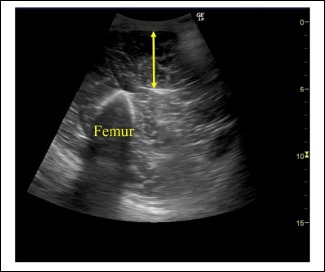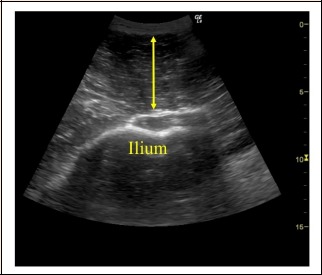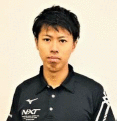Abstract
Hamstring strain injury is a multifactorial and complex problem involving interactions among various factors. Information about risk factors for this injury is inconsistent among studies because the strong effects of confounding factors and injury situations are often ignored. We investigated the relationship between hamstring strain induced by high-speed running and intrinsic risk factors, including hip muscle morphology and function, by excluding the influences of confounding factors. Sixty-one male track and field athletes (age, 19.6 ± 1.1 years; 95% confidence interval, 19.3–19.9) who often performed high-speed running were monitored throughout one season. Before the season, we measured hip and knee strength, muscle thickness of the gluteus maximus and biceps femoris, and hip and knee joint range of motion (ROM). We also obtained information about each athlete’s history of hamstring injury by questionnaire. Eighteen athletes sustained hamstring strain injuries induced by high-speed running. Eighteen uninjured athletes who had the same profile of confounding factors as the injured athletes were selected as controls. Previously injured athletes had a significantly higher injury rate than uninjured athletes (p < .05; odds ratio, 2.85). No other measurements had a significant relationship with the occurrence of injury. However, passive hip ROM (flexion and extension) tended to be larger in the injured than control group. A history of hamstring strain was a strong risk factor for hamstring strain injury, and it may affect other factors. Therefore, the risk factors for hamstring strain injury should be investigated by eliminating the impact of a history of hamstring strain.
Key points.
We examined the relationships between hamstring strain injury induced by high-speed running and function/morphology of hip/knee muscles.
We considered the effect of confounding factors such as previous history of hamstring strain. It has never been considered in previous studies of hamstring strain.
Isokinetic strength or muscle morphology of hip and knee muscles did not have association to hamstring strain injury. Injured athletes tended to have larger range of motion of hip than uninjured athletes.
Key words: Prospective study, sprinting, injury prevention, muscle strain injury
Introduction
Hamstring strain injury (HSI) is the most common injury in many sports, including high-speed running (Orchard et al. 1997). The incidence and recurrence rates of HSI are high in many sports (Brooks et al., 2006; Engebretsen et al., 2010). The proportion of HSI occurring during international athletic competitions (11.4%) is the highest among all injuries (Edouard et al., 2014). The prevalence of HSI in rugby players ranges from 6% to 12% (Brooks et al., 2006). Development of effective prevention programs and identification of the risk factors for HSI are under development. Van Mechelen et al. (1992) advocated the “sequence of prevention” of sports injuries. Many studies of sports injuries have been conducted based on this concept, which consists of the following four steps:
Establishing the extent of the sports injury problem (incidence and severity).
Establishing the etiology and mechanism of injury.
Introducing preventive measures.
Assessing their effectiveness by repeating Step 1.
Although many researchers have investigated the risk factors for HSI (Step 2), several unidentified factors (age and history of HSI) might be associated with the future occurrence of HSI (Freckleton and Pizzari., 2013). We consider that there are two reasons for the lack of clarity regarding the risk factors for HSI.
The first reason is that HSI can occur in various situations. HSI mainly occurs in two situations (Askling et al., 2006): high-speed running (high-speed running type) or extreme stretching of the hamstring by physical contact, falling, or dancing (stretching type). The risk factors for HSI will differ according to these situations. Most previously published studies of the risk factors for HSI have involved rugby, soccer, or Australian rules football players (Brooks et al., 2006; Orchard et al., 1997). However, these sports include both of the above-mentioned situations. More studies of restricted injury situations are needed to fully examine the risk factors for HSI. In the present study, we investigated the risk factors for only high-speed running type HSI. Additionally, when the injury situation is limited to sprinting, the risk factors for HSI must be reconsidered. We hypothesized that the occurrence of HSI is related to the function and morphology of the hip muscles. Therefore, we added hip muscle function and morphology to the previously investigated risk factors.
The second reason for the lack of clarity regarding the risk factors for HSI is that many previous studies did not consider confounding factors. The most recent meta-analysis of risk factors for HSI (Freckleton and Pizzari, 2013) used 15 questions that modified Downs and Black’s checklist (Downs and Black, 1998) to evaluate the quality of previous studies. The question that revealed inadequacy in most studies was “Was there adequate adjustment for confounding in the analyses from which the main findings were drawn?” A history of HSI, age, and sex are probably confounding factors between the occurrence of HSI and expected risk factors. A nested case-control study design is suitable for excluding the effects of some confounding factors.
The purpose of this study was to examine the risk factors for high-speed running type HSI by focusing on hip and knee muscle strength, morphology, and range of motion (ROM) by fixing effects of confounding factors. We hypothesized that injured athletes have limited ROM or muscle strength of the hip joint compared with uninjured athletes.
The theoretical significance of this study is the ability to accurately assess the physical risk factors for HSI induced by high-speed running. The practical significance of this study is to facilitate understanding results of physical examination and corresponding to athletes who have risk of HSI.
Methods
Study sample and participant selection
This was a prospective nested case-control study involving 61 male track and field athletes (sprinters, long jumpers, and decathletes) (age, 19.6 ± 1.1 years; height, 1.74 ± 0.05 m; body mass, 67.2 ± 5.0 kg). All athletes performed sprint running in their events. Athletes with any pain or discomfort at recruitment were excluded from this study. All participants provided written informed consent, and approval for the study was obtained by the Chukyo University Human Research Ethics Committee (approval No. 2016-4).
The preseason measurements were as follows:
Isokinetic hip flexion and extension muscle strength
Isokinetic knee flexion and extension muscle strength
ROM of hip flexion and extension
Passive knee extension test for assessing hamstring tightness
Muscle thickness of biceps femoris long head (BFlh) and gluteus maximus (GMax)
Questionnaire on whether the participants had a history of HSI
Assessments and measures: Strength tests
Isokinetic strength tests were performed using an isokinetic dynamometer (Biodex system 3; Biodex, Shirley, NY, USA). The participants performed all tests three times at the same angular velocity (60 deg/s). They conducted hip and knee tests on different days to exclude the effect of fatigue. We analyzed the peak torque per body weight (%) and agonist–antagonist peak torque ratio (hamstring–quadriceps ratio [HQ ratio] and iliopsoas–GMax ratio [IG ratio]).
In the hip test, the participant lay on the dynamometer, and his body was stabilized by straps on the chest, pelvis, and thigh of the untested leg. To prevent pelvic movement, the participant maximally flexed his neck and contracted his rectus abdominis. The knee angle was kept at 90 degrees throughout the measurement. The hip ROM was fixed at 115 degrees of flexion from full extension.
In the knee test, the participant was seated on the dynamometer, and his body was stabilized by straps on the chest, pelvis, and thigh of the untested leg. The knee ROM was fixed at 90 degrees of flexion from full extension.
Passive ROM
The passive hip ROM and hamstring tightness were measured using a goniometer. Many previous studies about the risk factors of HSIs have used passive ROM (Freckleton and Pizzari., 2013). To measure the hip flexion ROM, the participant lay supine on the clinical bed. The examiner touched the anterior superior iliac spine of the participant to recognize pelvic motion and then passively flexed the hip joint. The maximum flexion angle without pelvic motion was measured. The knee angle was kept in flexion.
To measure the hip extension ROM, the participant lay prone on the clinical bed. The examiner held the participant’s ilium to prevent pelvic motion. The examiner then passively extended the hip joint. The knee angle was kept in flexion.
Hamstring tightness was measured by the passive knee extension test. The participant lay supine on the clinical bed. The examiner bent the participant’s hip and knee at 90 degrees each. From this start position, the examiner passively extended the knee.
Muscle thickness
We measured the muscle thickness of the BFlh (Figure 1, measuring point: midpoint of a perpendicular line drawn from the upper end of the greater trochanter to the median sacral crest) and GMax (Figure 2, measuring point: midpoint of the ischial tuberosity and head of the fibula) with an ultrasound imaging instrument (LOGIQ e; GE Healthcare, Hino, Japan). The obtained image was analyzed by ImageJ software (National Institutes of Health, Bethesda, MD, USA).
Figure 1.

Ultrasonography of BFlh. Muscle thickness was the range of the solid line.
Figure 2.

Ultrasonography of Gmax. Muscle thickness was the range of the solid line.
Questionnaire
We also obtained information about each athlete’s history of HSI. A history of HSI was defined as “pain in the posterior thigh felt within the past 2 years and requiring rest for more than 1 day”. We asked each participant with a history of HSI about the timing and affected leg.
Definition of injury and sampling method of control group
HSI was required to meet all of the following three conditions:
Any posterior thigh complaint or manifestation experienced by an athlete, irrespective of the need for medical attention or time loss from athletic activities
Occurrence by high-speed running without physical contact
Requirement of more than 1 day of rest
The observational period was one competitive season from May 2016 to October 2016. We recorded the affected body part and side, type of event, mode of onset and cause of injury, and date of injury occurrence and full return to athletics practice. These items were assessed with reference to the consensus statement of epidemiological studies in athletics (Timpka et al., 2014). For each athlete, we defined participation in a practice or competition as 1 athlete exposure (AE) and calculated the incidence of HSI per 1000 AEs. The control group (uninjured athletes) was extracted from the cohort, and the number of control participants was equal to that of injured participants. To correct the influence of confounding factors, we randomly extracted control athletes who matched confounding factors with injured athletes from within the cohort. We extracted the control group according to the following procedure:
All athletes with the same history and events as the injured athletes were sampled.
Athletes were randomly sampled as controls from the athletes chosen in Step 1.
The same procedure was repeated for all injured athletes.
Statistical analysis
SPSS version 23 (IBM Corp., Armonk, NY, USA) was used for data analysis. The relationship between a history of HSI and the occurrence of injury during the observational period was analyzed by the chi square test. The normality of all data was analyzed by the Kolmogorov–Smirnov test. Differences in normally distributed data between the injured group and control group were analyzed by an unpaired t test, and differences in non-normally distributed data were analyzed by the Mann–Whitney U test. Results are expressed as average ± standard deviation (95% confidence interval) or median (interquartile range). The effect size (Cohen’s d) was determined to reveal the effect of each measurement on the occurrence of injury. The effect size was assessed as recommended by Cohen: d = 0.2, small; d = 0.5, medium; and d = 0.8, large. The correlations of the measurements were analyzed by Pearson’s correlation coefficient (normally distributed data) or Spearman’s rank correlation coefficient (non-normally distributed data). Logistic regression analyses were used to calculate the odds ratio. Results were considered to be significant at the 5% critical level (p < 0.05).
Results
Eighteen athletes (29.5% of all athletes) developed HSI during the observational period. In total, 6258 AEs were observed. Therefore, the incidence of HSI was 2.88/1000 AEs. There were no significant differences in age, height, or weight between the injured group (age: 19.3 ± 1.0 [18.8–19.8] years, height: 1.74 ± 0.06 [171–177] m, weight: 67.0 ± 5.3 [64.4–69.7] kg) and control group (age: 19.8 ± 1.3 [19.2–20.4] years, height: 1.75 ± 0.05 [172–177] m, weight: 67.1 ± 5.6 [64.3–69.9] kg). There were no significant differences in the injury occurrence ratio among short sprinters (100 or 200 m: 8/18 [44.4%]), long sprinters (400 or 800 m: 5/10 [50.0%]), hurdlers (110 or 400 mH: 1/9 [11.1%]), long jumpers (long jump or triple jump: 3/15 [20.0%]), and decathletes (decathlon: 1/9 [11.1%]) (p > 0.05).
History of HSI
The ratio of HSI during the observational period was significantly higher among legs with than without a history of HSI (p < 0.05; odds ratio, 2.85) (Table 1).
Table 1.
Differences in injury rate between the legs with history and the legs without history.
| History | |||
|---|---|---|---|
| PI | NPI | ||
| HSI | I | 9 | 9 |
| NI | 27 | 27 | |
| Ratio of injured legs (%) | 25.0 | 10.5 | |
The legs with history had significantly higher injury rate than the legs without history (p < 0.05, OR = 2.85).
Knee flexion and extension isokinetic strength
There were no significant differences between the groups in the peak torque of knee flexion (%) (injured group: 148.9 ± 21.3 [138.3–159.5], control group: 148.1 ± 28.6 [133.9–162.4]), peak torque of knee extension (%) (injured group: 284.3 ± 33.7 [267.5–301.1], control group: 283.7 ± 43.3 [262.1–305.2]), or HQ ratio (%) (injured group: 52.8 ± 7.8 [48.9–56.7], control group: 52.7 ± 9.6 [47.9–57.5]) (p > 0.05).
Hip flexion and extension isokinetic strength
There were no significant differences between the groups in the peak torque of hip flexion (%) (injured group: 251.1 ± 42.9 [229.8–272.4], control group: 254.0 ± 54.4 [226.9–281.0]), peak torque of hip extension (%) (injured group: 238.0 ± 19.1 [228.5–247.5], control group: 237.6 ± 33.5 [220.9–254.2]), or IG ratio (%) (injured group: 97.8 ± 20.0 [87.9–107.8], control group: 95.4 ± 12.3 [89.3–101.5]) (p > 0.05).
Passive ROM
Hip flexion ROM (°) in the injured group (115 [110–120]) tended to be larger than that in the control group (110 [110–115]). The effect size of hip flexion ROM for injury occurrence was medium (p = 0.064, d = 0.63). Hip extension ROM (°) in the injured group (17 [15.0–18.8]) also tended to be larger than that in the control group (15 [12.3–16.8]). The effect size of hip extension ROM for injury occurrence was medium (p = 0.095, d = 0.58). No significant correlation between hip flexion ROM and hip extension ROM was observed (p > 0.05, r = –0.061). Additionally, no significant difference in hamstring tightness (°) was observed between the groups (injured group: 54.2 ± 9.7 [49.3–59.0], control group: 60.3 ± 13.1 [53.8–66.8]) (p > 0.05).
Muscle thickness
There were no significant differences between the groups in the muscle thickness (cm) of the GMax (injured group: 5.3 ± 0.6 [5.0–5.6], control group: 5.1 ± 0.5 [4.8–5.3]) or BFlh (injured group: 4.0 ± 0.4 [3.8–4.2], control group: 3.9 ± 0.4 [3.7–4.1]) (p > 0.05).
Discussion
The purpose of this study was to examine the relationships between sprint-induced HSI and intrinsic risk factors (i.e., muscular strength, ROM, and muscle thickness) by fixing the effects of confounding factors (i.e., age and history of HSI). We hypothesized that injured athletes have limited ROM or muscle strength of the hip joint compared with uninjured athletes. However, there were no significant differences between groups in any measurements. Perhaps these measurements are not strongly related to HSI.
We found that 30% of the observed athletes had sustained HSI through high-speed running. In addition, the incidence of HSI was 2.88/1000 AEs. Each athlete in this study participated in 102.6 AEs during the season. This means that all track and field athletes will experience HSI at least once in four competition seasons. This study is the first to evaluate the incidence of HSI in track and field athletes. The prevalence of HSI in this study (29.5%) was higher than that a previous study of rugby athletes (6%–12%) (Brooks et al., 2006). Prevention of HSI is a top-priority issue in track and field. Future studies of the risk factors and preventive interventions for high-speed running type HSI are needed.
The results of this study indicate that a history of previous injury is an important risk factor for HSI and that it may affect other factors (i.e., serve as a confounding factor). Therefore, it is important to fix the effects of the patient’s history of injury and other confounding factors. However, the type of event had no significant relationship with the occurrence of HSI, suggesting that the event type is not a risk factor for HSI. Notably, the small sample size was a limitation of this study. Future studies of the relationship between HSI and the type of event are needed. From an anatomical point of view, the hamstring will be maximally stretched during hurdle jumping. Nevertheless, only one hurdler sustained HSI in this study. A higher number of subjects may provide more information about HSI.
The most recent systematic review and meta-analysis of the risk factors for HSI showed that previous studies in this area had the same problem regarding consideration of the existence of confounding factors. If confounding factors exist, the study findings cannot be regarded as true even if a significant relationship between the occurrence of HSI and expected risk factors is proven. This study provides the first evidence of the risk factors for sprint-induced HSI to fix the effects of confounding factors by study design. The nested case-control study design prevented the effects of confounding factors.
The ROM of hip flexion and extension tended to be larger in the injured group than in the control group. However, there was no significant correlation between hip flexion ROM and hip extension ROM (p > 0.05, r = –0.061). This means that an athlete with large hip flexion ROM does not necessarily have large hip extension ROM. However, the injured athletes in the present study had large ROM in both. Few studies have examined the association between HSI and hip ROM in muscles other than biarticular muscles. Most previous studies used the passive knee extension (Gabbe et al., 2005; 2006; Malliaropoulos et al., 2011; Rolls et al., 2004; Warren et al., 2010) test or active knee extension test (Arnason et al., 2004; Engebretsen et al., 2010; Rolls et al., 2004). These tests are performed to assess the flexibility of the hamstring muscle. The present study showed no significant association between HSI and the passive knee extension test result. To understand the effect of ROM on the occurrence of HSI, it is necessary to consider the relationships between these passive ROM measurements and the behavior of the joints during high-speed running. Future studies are needed to understand this problem.
The other strength and morphological measurements in this study had no significant relationships with HSI. In particular, several previous studies concluded that the peak torque of knee extension (Cameron et al., 2003; Freckleton and Pizzari, 2013) and the HQ ratio (Croisier et al., 2002; Yeung et al, 2009) are related to HSI. The results of the present study do not allow us to conclude that these measurements are unrelated to HSI. However, we can at least conclude that these factors are not strongly related to HSI. In future study, the effect of confounding factors will have to be fixed by using the study design of the present study or multivariate analysis.
The limitations of this study were the limited sample size, the fact that all athletes belonged to the same team (selection bias), and the inclusion of only male collegiate athletes. In addition, some measurements we conducted (muscle tests, ROM) lacked the specificity to the injury situation. For example, it’s unclear whether the results of passive ROM tests relate to the range of motion during sprint running. The muscle contraction speed and type of contraction during isokinetic strength tests also may differ from those during high-speed running. However, the tests we used are superior in terms of quantification. Future studies about the relationships between the results of these tests and the behavior of some joints and muscles during high-speed running are needed.
Conclusion
This study is the first to provide evidence of the risk factors for high-speed running type HSI by fixing the effects of confounding factors. The athlete’s history of injury has a large effect on the occurrence of HSI. No significant relationships between the other factors and occurrence of HSI were found.
Acknowledgements
We appreciate the teaching and helping of Graduate School of Chukyo University. The reported experiments comply with the current laws of the country; in which they were performed. The authors have no conflicts of interests to declare.
Biographies

Gaku TOKUTAKE
Employment
Graduate School of Health and Sport Sciences, Chukyo University
Degree
MSc
Research interests
Athletic training and sports medicine
E-mail: gtokutake@gmail.com

Rieko KURAMOCHI
Employment
Assoc. Prof., Graduate School of Health and Sport Sciences, Chukyo University
Degree
PhD
Research interests
Athletic training and sports medicine
E-mail: r-kuramo@sass.chukyo-u.ac.jp

Yuki MURATA
Employment
Graduate School of Education and Human Development, Nagoya University
Degree
MSc
Research interests
Education for sport injury prevention
E-mail: yuki.murata05@gmail.com

Shota ENOKI
Employment
Graduate School of Health and Sport Sciences, Chukyo University
Degree
MSc
Research interests
Athletic training and sports medicine
E-mail: chuxxxwpole0615@gmail.com

Yuki KOTO
Employment
Graduate School of Health and Sport Sciences, Chukyo University
Degree
BSc
Research interests
Athletic training and sports medicine.
E-mail: ykkotoh@gmail.com

Takuya SHIMIZU
Employment
Graduate School of Health and Sport Sciences, Chukyo University
Degree
PhD, MD
Research interests
Musculoskeletal sports disorders
E-mail: tshimizu@sass.chukyo-u.ac.jp
References
- Arnason A., Tenga A., Engebretsen L., Bahr R. (2004) A prospective video-based analysis of injury situations in elite male football: football incident analysis. American Journal of Sports Medicine 32, 1459-1465. [DOI] [PubMed] [Google Scholar]
- Askling C., Saartok T., Thorstensson A. (2006) Type of acute hamstring strain affects flexibility, strength, and time to return to pre-injury level. British Journal of Sports Medicine 40, 40-44. [DOI] [PMC free article] [PubMed] [Google Scholar]
- Brooks J.H.M., Fuller C.W., Kemp S.P.T, Reddin D.B. (2006) Incidence, risk, and prevention of hamstring muscle injuries in professional rugby union. American Journal of Sports Medicine 34(8), 1297-1306. [DOI] [PubMed] [Google Scholar]
- Cameron M., Adams R., Maher C. (2003) Motor control and strength as predictors of hamstring injury in elite players of Australian football. Physical Therapy in Sports 4, 159-166. [Google Scholar]
- Croisier J.L., Forthomme B., Namurois M.H., Vanderthommen M., Crielaard J.M. (2002) Hamstring muscle strain recurrence and strength performance disorders. American Journal of Sports Medicine 30(2), 199-203. [DOI] [PubMed] [Google Scholar]
- Downs S.H., Black N. (1998) The feasibility of creating a checklist for the assessment of the methodological quality both of randomised and non-randomised studies of health care interventions. Journal of Epidemiological Community Health 52, 377-384. [DOI] [PMC free article] [PubMed] [Google Scholar]
- Engebretsen A.H., Myklebust G., Holme I., Engebretsen L., Bahr R. (2010) Intrinsic risk factors for hamstring injuries among male Soccer players: a prospective cohort study. American Journal of Sports Medicine 38(6), 1147-1153. [DOI] [PubMed] [Google Scholar]
- Edouard P., Depiesse F., Branco P., Alonso J.M. (2014) Analyses of Helsinki 2012 European Athletics Championships injury and illness surveillance to discuss elite athletes risk factors. Clinical Journal of Sports Medicine 24(5), 409-415. [DOI] [PubMed] [Google Scholar]
- Freckleton G., Pizzari T. (2013). Risk factors for hamstring muscle strain injury in sport: a systematic review and meta-analysis. British Journal of Sports Medicine 47, 351-358. [DOI] [PubMed] [Google Scholar]
- Gabbe B.J., Bennell K.L., Finch C.F., Wajswelner, Orchard J.W. (2006) Predictors of hamstring injury at the elite level of Australian football. Scandinavian Journal of Medicine and Science in Sports 16, 7-13. [DOI] [PubMed] [Google Scholar]
- Gabbe B.J., Finch C.F., Bennell K.L., Wajswelner H. (2005) Risk factors for hamstring injuries in community level Australian football. British Journal of Sports Medicine 39, 106-110. [DOI] [PMC free article] [PubMed] [Google Scholar]
- Malliaropoulos N., Isinkaye T., Tsitas K., Maffulli N. (2011) Reinjury after acute posterior thigh muscle injuries in elite track and field athletes. American Journal of Sports Medicine 39, 304-310. [DOI] [PubMed] [Google Scholar]
- Orchard J., Marsden J., Lord S., Garlick D. (1997) Preseason hamstring muscle weakness associated with hamstring muscle injury in Australian footballers. American Journal of Sports Medicine 25(1), 81-85. [DOI] [PubMed] [Google Scholar]
- Rolls A., George K. (2004) The relationship between hamstring muscle injuries and hamstring muscle length in young elite footballers. Physical Therapy in Sports 5, 179-187. [Google Scholar]
- Timpka T., Alonso J.M., Jacobsson J., Junge A., Branco P., Clarsen B., Kowalski J., Mountjoy M., Nilsson S., Pluim B., Renstrom P., Ronsen O., Steffen K., Edouard P. (2014) Injury and illness definitions and data collection procedures for use in epidemiological studies in Athletics (track and field): Consensus statement. British Journal of Sports Medicine 48, 483-490. [DOI] [PubMed] [Google Scholar]
- Warren P., Gabbe B.J., Schneider-Kolsky M., Bennell K.L. (2010) Clinical predictors of time to return to competition and of recurrence following hamstring strain in elite Australian footballers. British Journal of Sports Medicine 44, 415-419. [DOI] [PubMed] [Google Scholar]
- Van Mechelen W., Hlobil H., Kemper H.C.G. (1992) Incidence, severity, aetiology and prevention of sports injuries. Sports Medicine 14(2), 82-99. [DOI] [PubMed] [Google Scholar]
- Yeung S.S., Suen A.M.Y., Yeung E.W. (2009) A prospective cohort study of hamstring injuries in competitive sprinters: preseason muscle imbalance as a possible risk factor. British Journal of Sports Medicine 43(8), 589-594. [DOI] [PubMed] [Google Scholar]


